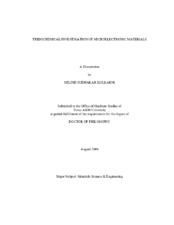| dc.description.abstract | To achieve efficient planarization with reduced device dimensions in integrated circuits, a better understanding of the physics, chemistry, and the complex interplay involved in chemical mechanical planarization (CMP) is needed. The CMP process takes place at the interface of the pad and wafer in the presence of the fluid slurry medium. The hardness of Cu is significantly less than the slurry abrasive particles which are usually alumina or silica. It has been accepted that a surface layer can protect the Cu surface from scratching during CMP. Four competing mechanisms in materials removal have been reported: the chemical dissolution of Cu, the mechanical removal through slurry abrasives, the formation of thin layer of Cu oxide and the sweeping surface material by slurry flow. Despite the previous investigation of Cu removal, the electrochemical properties of Cu surface layer is yet to be understood. The motivation of this research was to understand the fundamental aspects of removal mechanisms in terms of electrochemical interactions, chemical dissolution, mechanical wear, and factors affecting planarization. Since one of the major requirements in CMP is to have a high surface finish, i.e., low surface roughness, optimization of the surface finish in reference to various parameters was emphasized. Three approaches were used in this research: in situ measurement of material removal, exploration of the electropotential activation and passivation at the copper surface and modeling of the synergistic electrochemical-mechanical interactions on the copper surface. In this research, copper polishing experiments were conducted using a table top tribometer. A potentiostat was coupled with this tribometer. This combination enabled the evaluation of important variables such as applied pressure, polishing speed, slurry chemistry, pH, materials, and applied DC potential. Experiments were designed to understand the combined and individual effect of electrochemical interactions as well as mechanical impact during polishing. Extensive surface characterization was performed with AFM, SEM, TEM and XPS. An innovative method for direct material removal measurement on the nanometer scale was developed and used. Experimental observations were compared with the theoretically calculated material removal rate values. The synergistic effect of all of the components of the process, which result in a better quality surface finish was quantitatively evaluated for the first time. Impressed potential during CMP proved to be a controlling parameter in the material removal mechanism. Using the experimental results, a model was developed, which provided a practical insight into the CMP process. The research is expected to help with electrochemical material removal in copper planarization with low-k dielectrics. | en |


